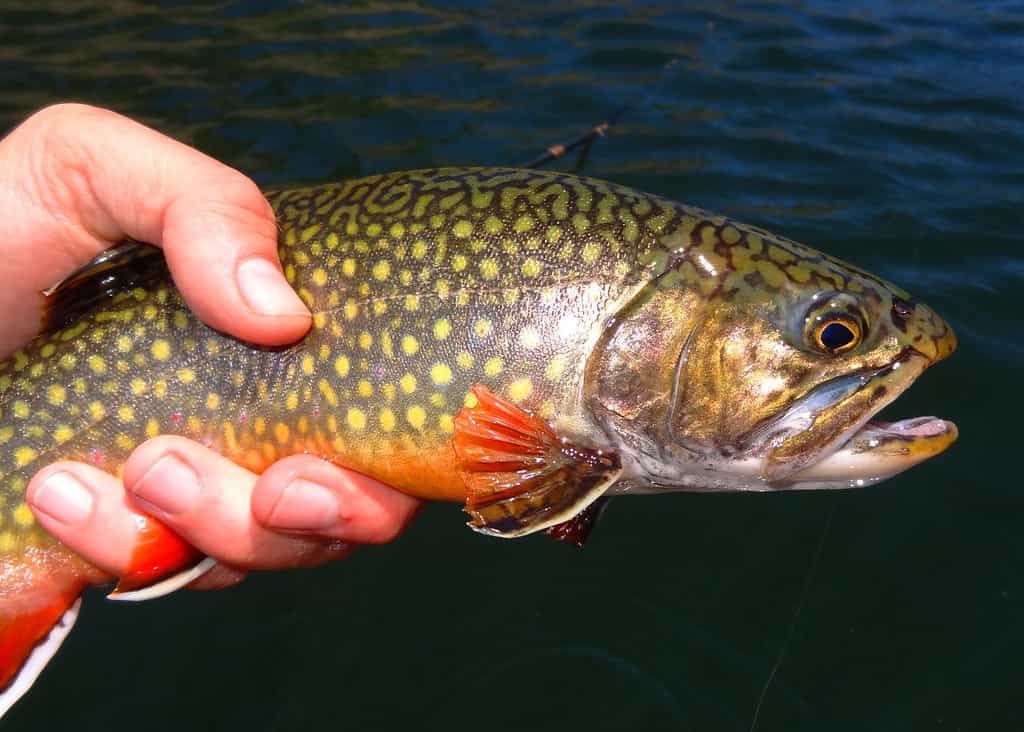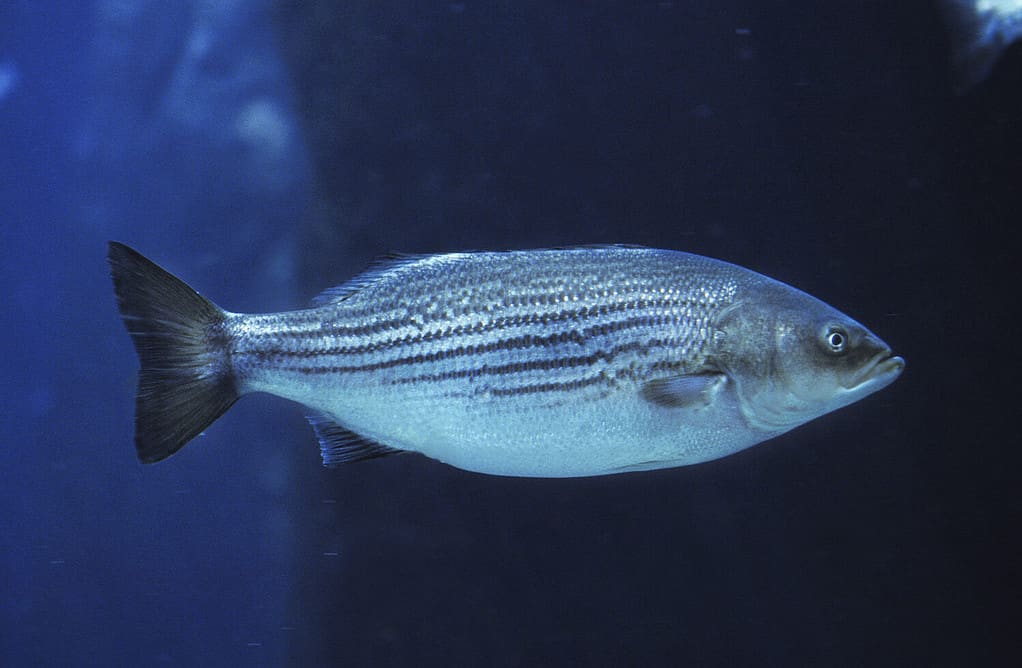Every US state has its own symbols, from state mammals and birds and fish to plants and even fungi! They all have their own unique meanings to the states they represent, and New Jersey’s state fish has an especially rich history in and importance to the area. Keep reading to learn all about this freshwater fish, its habitat, diet, appearance, and why New Jersey’s government has chosen it to represent their state.
Meet New Jersey’s State Fish: The Brook Trout

The New Jersey state fish is the brook trout. In 1991, the state’s legislature passed Assembly Bill 2608 to officially make the brook trout one of New Jersey’s state symbols, and Governor James J. Fiorio signed it on January 8th, 1992.
Native to New Jersey and much of the northeastern United States, the brook trout is a rather popular state symbol–it actually represents nine different states as their state fish! It is currently the state fish of not just New Jersey but also New York, Michigan, New Hampshire, Pennsylvania, Vermont, Virginia, West Virginia, Georgia, and North Carolina. However, it’s worth noting Georgia and North Carolina choose to specifically recognize the Southern Appalachian brook trout as their state fish, which is actually a subspecies of the brook trout.
According to the New Jersey Division of Fish and Wildlife, there are at least 123 streams and waterways in the state that produce and support native brook trout populations. Because the species must live in cool, clear water, its presence is often an indicator of good water quality!
Notably, brook trout also need to spawn in water with very rocky substrate. Thanks to this and their preference for chilly, clear water, they most commonly live in colder, more mountainous regions of the United States. This is in part why mainly northern states in the Great Lakes and New England regions recognize them as their state fish, as this is where they are most abundant.
Brook Trout Size, Diet, and Fun Facts

Brook trout have prominently mottled yellow, blue, and red patterning.
©M Rose/Shutterstock.com
The brook trout is most easily recognizable by its distinctly mottled patterning. Its long, somewhat slender dark greenish-brown body is accented by lots of tiny, yellowish spots, along with a sprinkling of reddish dots along its sides, which are handsomely outlined by vibrant blue halo-like markings. Its belly and lower fins are similarly reddish in color, making the brook trout a rather colorful and visually striking fish.
In terms of size, brook trout are quite long and lean. Fully-grown adults can range from as little as 10 inches to up to 25 inches in length. Additionally, they can weigh anywhere from half a pound to over six pounds. The largest recorded brook trout, however, weighed a whopping 15 pounds and measured 34 inches long.
Many environmental factors can affect brook trout growth rates. Chief among them are water and air temperature as well as water flow and location. Growth rates can even vary with the seasons, with most brook trout growing more quickly during the early spring months.
The brook trout’s diet is incredibly varied, as the fish are not particularly picky eaters. They eat all manner of aquatic and even some non-aquatic insects, as well as other species like frogs, crustaceans, and mollusks. Interestingly, they also occasionally feed on smaller fish, even other, smaller brook trout. Even small, aquatic mammals can sometimes be on the brook trout’s menu.
Although brook trout are mainly native to the northern and especially northeastern regions of the United States, they have also spread to other parts of North America. They’ve been introduced as far west as Washington and California. Some populations have adapted to live in much warmer areas like Hawaii, Texas, and Florida.
Where Do Brook Trout Live in New Jersey?

Brook trout thrive in cool, clear water.
©K Steve Cope/Shutterstock.com
The brook trout is native to much of the northeastern reaches of the United States. It lives throughout New Jersey’s rivers, creeks, and streams. Like we touched on briefly earlier, it generally prefers very cold, well-oxygenated, clear water with a very narrow pH range of just 5.0 to 7.5.
The temperature range the fish thrives in is also fairly narrow at around 35F to 72F. Studies have shown that climate change and the associated rising temperatures during the summer can be stressful for the fish, especially smaller juveniles and the viability of brook trout eggs.
In New Jersey in particular, brook trout are most abundant in the northern half of the state. They’re especially common in mountainous areas like the Watchung Mountains. This is thanks to the area’s more rocky substrate, which is ideal for brook trout spawning.
Brook trout are most active in New Jersey during the springtime months when water temperatures are within their ideal range. Additionally, the New Jersey Division of Fish and Wildlife primarily stocks brook trout during the spring each year.
Can You Catch Brook Trout in New Jersey?

Brook trout are popular game fish in New Jersey.
©Matt Jeppson/Shutterstock.com
The brook trout has long been a popular game fish in the northeastern United States thanks to its visually striking appearance and manageable size. They’re also quite easy to catch even for novice anglers and are especially popular amongst fly fishers.
Fortunately, you can catch them in New Jersey–provided you’re willing to get a fishing license and trout stamp. Fishing licenses are quite affordable in the Garden State, with resident fishing licenses for anglers aged 16 to 65 starting at around $22. The trout stamp required for species like the brook trout can cost an additional ~$10 for state residents.
If you’re 70 years old or older, the fee is essentially waived. Senior anglers do not require a license or stamp. For out-of-state folks, licenses and trout stamps are slightly more expensive, starting at $34. Be sure to always display the badge on your clothing or have it handy while fishing.
While searching for brook trout, be sure to keep the Brook Trout Conservation Zone and its associated regulations in mind. Established in 2018 in response to a Wild Trout Stream Assessment conducted four years prior, any fish caught within the zone must be immediately released unharmed. This helps to protect and sustain native brook trout populations.
Like we mentioned earlier, it’s best to go fishing for brook trout during the spring and early summer months when water temperatures are just right for the species to spawn and thrive.
Over a hundred streams and waterways support native brook trout populations, with some of the most prominent being Van Campens Brook near the Delaware Gap Recreation Area and Dunnfield Creek. In particular, Van Campens Brook is one of the few areas that supports all three native brook, brown, and rainbow trout species.
New Jersey’s State Salt Water Game Fish: The Striped Bass

The striped bass is New Jersey’s official state saltwater game fish.
©slowmotiongli/Shutterstock.com
Before we wrap things up on New Jersey’s state fish, it’s worth mentioning that the state actually has two state fish species. Aside from the brook trout, it also has a state saltwater game fish, the striped bass, which was officially selected to represent the state in 2017. Currently, the species is the state saltwater fish of New Jersey, Virginia, and New Hampshire. It’s also the state fish of Maryland, Rhode Island, and South Carolina.
The striped bass gets its common name from the distinct pattern of thin, dark gray horizontal stripes running along the sides of its pale, silvery body. On average, it ranges from 20 to 35 inches long.
Despite being fairly long and lean, it’s still a rather hefty fish, weighing anywhere from 5 to 40 pounds when fully mature. Especially large individuals can exceed this range, though most specimens tend to max out at around 20 pounds. The largest striped bass on record was a massive 124 pounds.
The species’ geographic range covers much of North America’s Atlantic coast. While they are generally a saltwater species, striped bass actually migrate from salt to freshwater seasonally and spawn in freshwater.
In addition to its lean yet muscular and robust body, extensive geographic range, and hardy nature, the striped bass also enjoys a lengthy lifespan. Researchers believe it can live for up to 30 years.
The photo featured at the top of this post is © Slowmotion GLI/Shutterstock.com
Thank you for reading! Have some feedback for us? Contact the AZ Animals editorial team.







